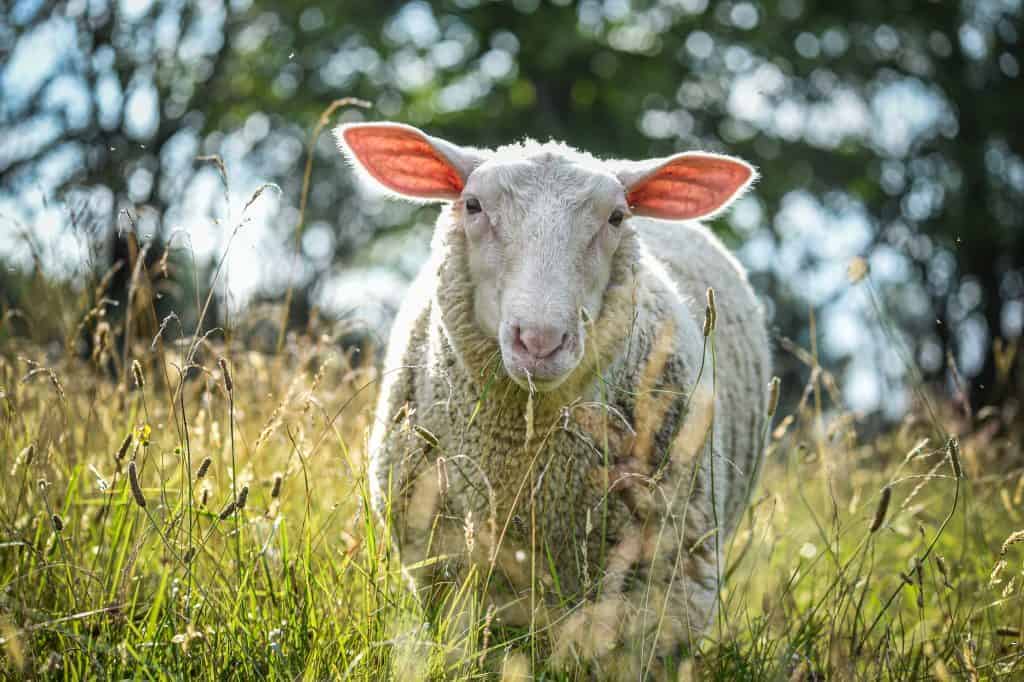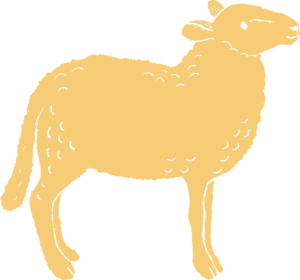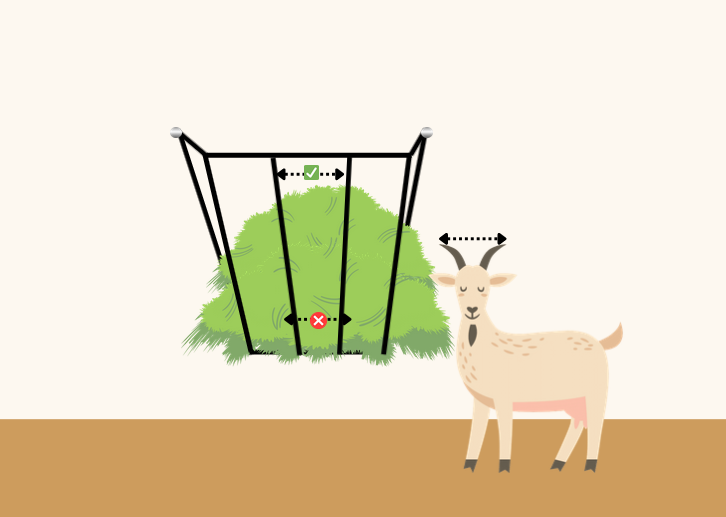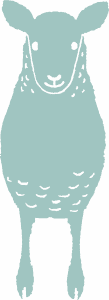
This resource has been partially reviewed and updatedA member of The Open Sanctuary Project’s staff has updated one or more sections within this resource. by a member of The Open Sanctuary Project team as of June 8, 2023.
If you’re reading this resource, there are likely some special sheep residents in your life for whom you’d like to provide the best possible care! The compassionate lifelong care of sheep at animal sanctuaries starts with the food they’re provided. While sheep are all individuals who have their own preferences and needs, there are some general principles to consider regarding their physiology and nutritional requirements!

Young Lambs Have Their Own Dietary Needs!
For information about the dietary needs of lambs, check out our resource here.
Like goats and cowsWhile "cows" can be defined to refer exclusively to female cattle, at The Open Sanctuary Project we refer to domesticated cattle of all ages and sexes as "cows.", sheep are ruminants, and their complex digestive system allows them to efficiently digest and utilize high-fiber foods that are primarily composed of cellulose. Ruminants are sometimes mistakenly described as having four stomachs, but in reality, they have one stomach with four compartments – the rumen, reticulum, omasum, and abomasum.
The rumen is the largest compartment and is essentially a fermentation vat. Fifty to sixty percent of the starch and digestible sugars consumed are digested in the rumen. Microbes break down tough plant matter and form volatile fatty acids (VFAs) which account for over 70% of a ruminant’s supply of energy. These microbes can also utilize non-protein nitrogen sources to synthesize protein and can synthesize B vitamins and vitamin K. Abrupt changes in diet can affect rumen microbes, and if large amounts of soluble carbohydrates, such as in the form of concentrates (foods such as corn, oats, wheat, soybean meal, molasses, etc. which are low in fiber and high energy and/or protein) are consumed, rumen pH can drop, destroying many microbial species, slowing motility, and causing serious issues.
General Recommendations
The best diet for healthy, mature sheep is one consisting primarily (often exclusively) of appropriate forages (plants/plant materials) plus mineral supplementation. The specific types of forages you offer will not only depend on what is appropriate and preferred by your residents, but also what is available in your area. Forages can be fresh, in the form of vegetation growing in the individual’s living spaceThe indoor or outdoor area where an animal resident lives, eats, and rests., or dried, in the form of hay.
When considering what to include in a sheep resident’s diet, keep the following in mind:
- Fiber– Fiber plays an important role in rumen function, and generally fiber content should be greater than 50%.
- Protein– According to Drs. Darrell L. Rankins, Jr. and D.G. Pugh, sheep need a minimum of 7% dietary crude protein for normal rumen function and normal rumen bacterial growth. While some individuals may require diets higher in crude protein (such as pregnant individuals, mothers who are nursing their babies, individuals who are still growing, or individuals with certain health challenges), the maintenance recommendation of 7-8% is appropriate for most mature sheep residents, and most forages provide enough protein to meet this requirement. In adult ruminants, the quality of dietary protein is not as important as the quantity.
- Calcium-to-phosphorous ratio– We’ll talk more about mineral supplementation later in this resource, but it’s important to point out that you should maintain a calcium-to-phosphorous ratio of 2:1 to prevent urinary calculi. When thinking about calcium-to-phosphorus, be sure to consider all of your residents’ mineral sources – forages, mineral supplements, water, and any supplemental food sources.
How Much Food Do Sheep Need?
The amount of food a sheep needs is often estimated on a dry matter basis (“dry matter” refers to what would remain if all of the moisture was removed from the food). The amount of dry matter a sheep needs to consume per day in order to meet their nutritional needs depends on many factors including the temperature, the type and quality of the food, and the individual (their weight, life stage, general health, and activity level all factor in). Because of this, there is a wide range of estimates different sources provide regarding dry matter intake. To keep things simple, we’ll highlight just one recommendation to provide a general idea of dry matter intake needs. According to Susan Schoenian, Sheep & Goat Specialist for University of Maryland Extension, in order to meet their nutritional requirements, sheep generally need to consume 2-4% of their body weight in dry matter.
So, how do you go about turning this dry matter recommendation into an actual amount of food to offer? By offering forages, whether fresh or dried, on a free-choice basis, individuals can consume as much food as they need. “Free-choice” simply means making sure food is constantly available so that the individual can eat as much as they wish. Please note that some individuals may require additional supplementation, on top of this, in which case your veterinarian can make specific recommendations regarding their dietary needs.
Forages
As mentioned above, a forage-based diet is best for healthy, mature sanctuary sheep. Forages can be provided in fresh or dried form. The availability of fresh forages is highly dependent on your region and climate. Depending on where you are located, fresh forages growing in your residents’ outdoor living spaces may be available year-round, but in most areas they will only be available seasonally. Please keep in mind that just because appropriate fresh forages are available in your residents’ living space does not mean that they grow in sufficient quantities to be your residents’ primary food source. When fresh forages are not available, are only available in small quantities, or are of poor quality, your residents should be fed grass hay (either as their primary food source or to supplement fresh forages).
Fresh Forages
In areas where fresh forages are available, it’s important to consider the foraging preferences and natural behaviors of sheep. Some ruminants are grazers, others are browsers, and some are a mix of both (intermediates). While some folks categorize sheep as grazers and others categorize them as intermediates, we’re going to call them grazers to keep things simple. Sheep primarily eat grasses and forbs (herbaceous broadleaf flowering plants, including legumes), often seeking out forbs first when grazing. They will typically graze for 7 or 8 hours a day, often in the early morning and late afternoon/evening.
Whether you are establishing a new pasture or working with an existing one, your local cooperative extension office can be a great resource. They should be able to recommend a pasture seed mix for your residents that will grow well in your area and can also offer guidance for renovating existing pasture spaces, but be sure to explain to them who your residents are. Extension agents are likely used to working with folks who are focused on “productivity” and who care for animals with different needs than those of sanctuary residents. Of particular note – if you care for male sheep, it’s important to raise the issue of urinary calculi, as certain plants (or certain proportions of plants) may not be appropriate for neutered males.
In a sanctuary setting, grasses should typically make up a large percentage of pasture vegetation, with a smaller percentage of legumes and other forbs. Legumes are usually higher in calcium and protein and can also cause bloat, so legumes should be incorporated thoughtfully.

Beware Of Toxic Plants!
Before giving sheep residents access to outdoor spaces, ensure that they have been thoroughly checked for toxic plants!
Pasture Management
Pasture vegetation will need time to rest and regenerate, and this is most easily accomplished by dividing outdoor spaces into different areas residents can rotate through. This way, while vegetation in one area is regenerating, residents can graze in a different area. If residents have access to only one pasture space, even if it is very large, they can easily overgraze certain areas, resulting in damage to plants. Sheep have a tendency to graze pastures all the way down to the ground if allowed to do so.
The specific rotation system and schedule you should follow will depend on many factors including the size and make-up of your pasture, your resident population, regional weather, and whether or not parasites are a concern (and to what extent). Pasture rotation should balance the following considerations:
- Plant health– residents should be moved off a pasture before they are able to damage vegetation. How heavily plants can be grazed depends on the species and their life stage. If you work with a cooperative extension agent to determine the best plants to grow, talk to them about their recommendations for pasture management. Generally speaking, you want to move residents off a pasture when it reaches 3-4 inches in height to protect against overgrazing.
- Nutritional value of pasture– as pasture plants mature, they lose nutritional value and become less palatable. Therefore, letting pastures go too long without being grazed or mowed could result in pasture that is both less nutritious and less palatable.
- Parasite concerns– if you are in an area where barber pole worm or other internal parasites are a concern, you’ll want to consider the best way to reduce your residents’ exposure while grazing. You can read more about pasture management as it relates to barber pole worm here.
Grass Hay
When fresh vegetation is not available (or is not available in sufficient quantities), residents will need to be fed grass hay, such as timothy or orchard grass. The specific variety will depend a lot on your location and what is available. There may be certain situations where your veterinarian recommends legume hay (such as alfalfa) for certain residents but, generally, grass hay will be the most appropriate for healthy, adult sheep residents, especially neutered males (due to their risk of urinary blockage).
Hay can come in multiple cuttings, with 1st and 2nd being the most frequently used. The cutting simply indicates when the hay was harvested (cut) for the season – first cutting was harvested first, second cutting is harvested second, and so on. In some areas, first cutting may be all that is available to you – it all depends on your region, the growing season, and your supplier. Depending on the type of hay you use, there may be physical and nutritional differences between the different cuttings. For example, when comparing first and second cutting timothy hay, first cutting is typically coarser than second cutting, which is often richer, softer, and also more expensive (though in some cases, first and second cutting may look very similar).
Never feed residents moldy hay, and be sure to remove hay if it becomes soiled. In order to ensure free-choice access, check hay levels at least twice a day, replenishing as needed, and removing hay that has been sitting in the feeder for more than a few days. To keep hay from becoming sun-bleached or wet, offer hay indoors or in covered areas that protect it from the elements.
Remove All Baling Material!
When feeding out hay, be sure to remove the baling material used to hold the bale together. Failing to do so can result in injury and can have dire consequences if ingested. Small bales will typically come baled with twine or wire. Wire can result in puncture injuries and twine can be accidentally ingested or become wrapped around a resident, putting them at risk of injury or strangulation. Learn more about this challenge at your sanctuary here.
Hay Feeders
It’s best to provide hay in a hay feeder in order to keep it clean and dry and to reduce waste. Placing hay directly on the ground not only results in more waste but can also result in exposure to internal parasites and other pathogens. There are many options when it comes to hay feeders, ranging from wall-mounted feeders to freestanding ones. While feeders can be purchased from farm supply stores, some sanctuaries choose instead to build their own.
When choosing a hay feeder, it’s very important to keep resident safety in mind. We’ve heard multiple heartbreaking stories of goats suffering serious injury and even death as a result of certain types of hay feeders, and while this issue seems to be more of a concern in goats, out of an abundance of caution, we recommend avoiding these types of feeders for sheep as well. While we will call out a few types of feeders here for the risks they pose, please be sure to thoughtfully assess any feeder you decide to use. Due to the risk of entrapment and strangulation, we strongly recommend folks avoid using hay nets and hay bags. Additionally, certain wall-mounted hay feeders can pose the risk of entrapment, particularly styles with tapered vertical bars that have wider gaps towards the top that narrow at the bottom. A resident may fit their entire head in the gap at its widest point but then become trapped when they bring their head closer to the ground (if the resident has horns, this can further enhance the risk).
Here’s a graphic to demonstrate the risk involved with this style feeder:

Regardless of feeder design, be sure to watch closely for any issues and make changes as needed so your residents can eat safely and comfortably.
What About Grains, Pellets, And Concentrates?
A healthy, mature sheep who is neither pregnant nor lactating will not typically require supplementation with grains, pellets, or concentrates and will instead rely on fresh and/or dried forages (plus supplemental minerals, described next). However, residents with certain health challenges (such as cancer, chronic parasitism, or Ovine Progressive Pneumonia) may require supplemental food. Additionally, residents with dental disease, which becomes more common with age, may not be able to break down tough forages and may require supplemental food sources. If one of your residents appears to not be thriving or maintaining a healthy weight on the standard diet of fresh and/or dried forages, be sure to consult with your veterinarian to determine the cause.
In addition to addressing any underlying conditions, you may need to provide the individual with supplemental food, either on a temporary or permanent basis. We recommend working with a veterinarian or nutritionist to determine the best diet based on the individual’s specific needs – this may include dry or soaked hay pellets, concentrates, or a mix of these plus beet pulp and other foods. It will be important to consider rumen health when determining the best supplemental foods, and for males, be sure to also discuss their risk of urinary calculi. Large amounts of concentrates are not typically recommended. When supplementing a sheep’s diet, be sure to choose commercial formulations that are labeled for sheep, as those intended for other species may have toxic levels of copper.
Defer to your veterinarian’s instructions, but remember that abrupt diet changes can affect the complex web of rumen microbes, and large amounts of soluble carbohydrates (such as concentrates) can cause rumen pH to drop, destroying many microbial species, slowing motility, and causing serious issues. Therefore, any changes in their diet and the introduction of new foods should be made gradually.
Keep Supplemental Food Securely Stored!
Be sure to keep concentrates and other supplemental foods securely stored in an area where residents cannot access them! If sheep gain access to food stores, they can quickly gorge themselves which puts them at risk of life-threatening gastrointestinal issues.
Vitamin And Mineral Supplementation For Sheep
Just as with humans, vitamins and minerals play an important role in sheep nutrition and health. An appropriate diet for sheep is one that includes vitamins A, D, and E. Because rumen microbes synthesize B vitamins as well as vitamin K, these typically do not need to be supplemented in healthy individuals. However, individuals with certain health challenges or who are on certain treatments may require supplementation – especially with B vitamins.
Essential minerals are categorized as macrominerals (also referred to as major minerals) and microminerals (also referred to as trace minerals). These designations are based on the amount of the mineral that is necessary, not the importance of the mineral. Microminerals are needed in lower levels than macrominerals but are no less important. Essential minerals include calcium, phosphorus, magnesium, sodium chloride (salt), potassium, sulfur, iron, iodine, zinc, copper, molybdenum, selenium, and cobalt.
Some of these nutrient requirements are easily met under normal circumstances, while others need to be more carefully considered and monitored. When determining the best supplementation for your residents, it’s important to work with an experienced veterinarian or nutritionist and to look at your residents’ entire diet and other potential sources of nutrients. Some nutrients are interrelated, which means that too much or not enough of one nutrient can impact how much of another nutrient is needed. For example, increased levels of one nutrient can interfere with the absorption of another. Therefore, it is important to work with someone who understands how different nutrients are related and who can help determine the most appropriate supplementation for your residents.
Your veterinarian may recommend testing your forages and/or performing certain diagnostic testing on your residents to help determine appropriate supplementation. Unfortunately, for certain nutrients, diagnostic testing can be complicated, which is why it is important to work with an experienced veterinarian. When considering supplementation, it’s also important to factor in any soil deficiencies in your area. For example, if you are in an area with selenium deficient soil, you’ll likely need to carefully supplement this important nutrient.
Free-Choice Salt-Based Supplements
Providing a free-choice mineral supplement will help ensure your residents get the minerals (and in some cases, vitamins) they need, but please note that depending on your residents’ needs, other methods of supplementation may be necessary on top of this. Complete mineral formulations typically contain salt, calcium, phosphorus, and trace minerals. A trace mineral salt is just that – trace minerals and salt without any of the macrominerals (like calcium or phosphorus). Not all complete or trace mineral formulations contain selenium, so be sure to pay attention to whether or not it is included.
Mineral formulations come in loose or block form, but loose formulations are often recommended over blocks because the block’s hard form can make adequate consumption difficult. Additionally, there is the concern of a resident breaking a tooth on a mineral block. While it is possible to mix your own loose mineral formulation, this may not be advisable. Mixing errors can have severe consequences, so it may be best to choose a commercial formulation. If you do decide to mix your own trace mineral salt formulation, this should be done in conjunction with a veterinarian or small ruminant nutritionist and mixing must be done extremely carefully.
We recommend talking to your veterinarian or an experienced nutritionist when choosing a commercial mineralized salt formulation for your residents, taking into account your resident population, their diet, and regional factors (such as soil deficiencies). Because salt is what encourages the consumption of trace minerals, no other forms of salt should be provided to your residents. Additionally, providing multiple mineral formulations at the same time is typically not recommended because it makes it difficult to determine how much of each nutrient your residents are receiving.
As with commercial food formulations, sheep must only have minerals formulated specifically for sheep so as to avoid copper toxicity.
Copper Complications
If you have sheep residents living with goats or other residents who require mineral supplementation, the entire group will need to have minerals that are safe for sheep, which could result in deficiency for species with higher copper needs. Be sure to work with your veterinarian to determine how to best meet the needs of all your residents. This includes determining whether or not additional copper supplementation is necessary for non-sheep residents and, if it is, how to safely provide this. For example, while adult goats are less susceptible to copper toxicity than sheep, supplementing with too much copper or supplementing without assessing your goat residents’ copper intake from food, minerals, water, and other sources could result in copper toxicity, which can be fatal.
It’s important to pay attention to your residents’ intake of mineralized salt formulations to ensure they are consuming the appropriate amount. Of course, in a group setting, it is impossible to know how much each individual is consuming, but paying attention to how quickly (or slowly) the mineralized salt is being consumed will give you an idea of if residents are consuming too much or too little. Formulations will come with specific directions regarding how much should be consumed, so be sure to pay attention to this. Some formulations may not be palatable, which will result in residents not consuming enough, potentially leading to deficiencies.
There are various styles of mineral holders available at farm supply stores as well as DIY options. Be sure to provide enough mineral stations so that residents can easily consume them at their leisure. Offering minerals in just one location could lead to some residents being pushed away. Instead, be sure to space them out and keep them in areas where residents spend their time, ideally near water sources. If providing minerals outdoors, be sure to use a covered feeder to protect minerals from rain and snow, and make sure the feeder is one your residents can comfortably use.
Check mineral levels regularly, replacing as needed to ensure continuous access. Loose minerals can become hard if they get wet (which, even when covered, may happen due to humidity or your residents’ saliva), so be sure to pay attention to this, breaking up or replacing loose minerals that have become hard.

Worried About Deficiencies?
Even with an appropriate diet and mineral supplementation, deficiencies are still possible. If you are concerned about specific vitamin or mineral deficiencies or are worried one of your residents is showing signs of a deficiency, you should consult with your veterinarian.
Water For Sheep
Like every sanctuary resident, sheep require a clean, freely-accessible water supply. The amount of water your residents will consume in a day varies based on their size, the temperature, and the water content of their food, but in general a non-lactating sheep will drink 1-2 gallons of water each day. Water consumption will increase as temperatures rise, and individuals eating hay will drink more water than those eating lush grass and other vegetation due to the much lower moisture content of hay.
To ensure residents have continuous access to fresh water, it’s helpful to have water units that refill automatically rather than having to be manually refilled – this is especially helpful if you care for more than just a few sheep. If you are able to, installing automatic waterers is a good option. If temperatures dip below freezing, autowaterers with safe heating elements and thermostats can keep water from freezing.
If installation of an autowaterer is not possible, or if you are looking for a watering setup that can be moved (such as if you are providing water in outdoor spaces and need to move the setup when residents move to a new outdoor space, buckets, bowls, and troughs can be good options depending on the number of residents in the group.
If you live in an area where water is likely to freeze, but are unable to install heated autowaterers, you’ll need to take steps to ensure your residents have continuous access to non-frozen water. While there are some heated buckets and tank heaters available, be sure to consider any fire and other safety risks these setups may pose and use them very carefully, making sure all cords and heating elements are protected from curious residents who may chew, damage, or play with them. Also keep in mind that water may still freeze despite these heaters. Be sure to check water frequently, and replace water that is starting to freeze with fresh water. Also keep in mind that sheep may be less inclined to drink if water is ice cold, even if it is not frozen, so regularly providing warm water may be best.
Treats For Sheep
Treats, while delicious, should make up a very small percentage of a sheep’s diet. Remember, to avoid disturbing rumen microflora, new foods should be introduced slowly and in small quantities. To avoid choking hazards, make sure treats are chopped up in bite-sized pieces.
While not an exhaustive list, for the occasional treat, consider offering the following tried and true treats:
- Carrots
- Celery
- Apple
- Watermelon
- Blueberries
- Strawberries
- Raspberries
- Bananas
- Grapes
To make treats last, try out some nutritional enrichment strategies!
Foods You Should Not Feed To Sheep
There are a number of foods that contain potential toxins or substances sheep cannot digest or tolerate. You can find our list of potentially toxic foods here.
Food Recommendations For Older Sheep
While some older sheep residents may continue to thrive on a standard sheep diet consisting of fresh or dried forages, others may require certain modifications or supplementation. It is not uncommon for elderly sheep to lose weight, which could be due to various issues such as dental disease, an underlying health condition (such as OPP), or eating less due to environmental factors or social dynamics. You should be very mindful of an older sheep’s weight so that you can catch weight loss early. It’s important to identify the cause of the weight loss, take steps to address the issue, and make changes to their diet, living arrangement, and/or environment, based on their needs. In some cases, you may need to separate the individual one or more times per day so you can offer them supplemental foods to ensure they are getting all the nutrients they need. To read more about diet recommendations for older sheep, in addition to other care considerations, check out our resource here.

Interested In Learning More About Sheep Care?
Head over to our Compassionate Care Classroom and check out Basic Sheep And Goat Care Part 1 which covers diet, housing, social considerations, and enrichment for sheep. The information above is an abbreviated version of the diet section of the course.
SOURCES:
Digestive Physiology of Herbivores | VIVO Pathophysiology
Rumen Physiology and Rumination | VIVO Pathophysiology
Fermentation Microbiology And Ecology | VIVO Pathophysiology
Advanced Topics In Resident Health: Barber Pole Worm | The Open Sanctuary Project
Urinary Calculi in Wether Lambs/Kids
Sheep And Goat Medicine, Second Edition (Non-Compassionate Source)
Nutrient Absorption And Utilization In Ruminants | VIVO Pathophysiology (Non-Compassionate Source)
Food Requirements For Different Animals | Noble Research Institute (Non-Compassionate Source)
Nutritional Requirements of Sheep | Merck Veterinary Manual (Non-Compassionate Source)
An Introduction To Feeding Small Ruminants | Maryland Small Ruminant Page (Non-Compassionate Source)
What Sheep Eat | Sheep 101 (Non-Compassionate Source)
Grazing preferences Of Sheep And Goats | Nebraska Extension (Non-Compassionate Source)
Managing Pastures For Sheep | Sheep 201 (Non-Compassionate Source)
LivestockAnother term for farmed animals; different regions of the world specify different species of farmed animals as “livestock”. Winter Hay Needs | OSU Sheep Team (Non-Compassionate Source)
Minerals And Vitamins For Sheep | Mark L. Wahlberg, Extension Animal Scientist (Non-Compassionate Source)
Non-Compassionate Source?
If a source includes the (Non-Compassionate Source) tag, it means that we do not endorse that particular source’s views about animals, even if some of their insights are valuable from a care perspective. See a more detailed explanation here.








